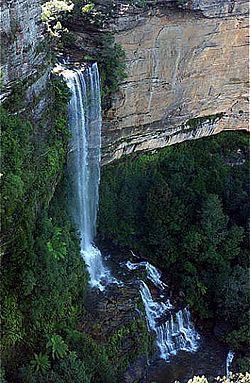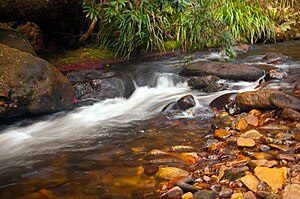| Kedumba Kedumba Creek (Part), Katoomba Creek (Part)[1] | |
|---|---|
 Kedumba River descending into the Jamison Valley over the Katoomba Falls, viewed from Scenic World, Katoomba, 2013. | |
Location of the Keduma River mouth in Lake Burragorang, New South Wales | |
| Location | |
| Country | Australia |
| State | New South Wales |
| Region | Sydney Basin (IBRA), Blue Mountains, Macarthur |
| LGAs | Blue Mountains, Wollondilly |
| Physical characteristics | |
| Source | Blue Mountains |
| • location | Walford Park, Katoomba, Blue Mountains (New South Wales) |
| • coordinates | 33°42′54″S 150°18′23″E / 33.71500°S 150.30639°E |
| • elevation | 556 m (1,824 ft) |
| Mouth | confluence with the Coxs River to form Lake Burragorang |
• location | Policeman Point, Warragamba |
• coordinates | 33°51′21″S 150°20′27″E / 33.85583°S 150.34083°E |
• elevation | 120 m (390 ft) |
| Length | 20 km (12 mi) |
| Basin features | |
| River system | Hawkesbury-Nepean catchment |
| Waterfalls | Katoomba Cascades, Katoomba Falls |
| National park | Blue Mountains National Park |
| [1][2] | |

The Kedumba River, a perennial river that is part of the Hawkesbury-Nepean catchment, is located in the Blue Mountains and Macarthur regions of New South Wales, Australia.
Course and features
[edit]The Kedumba Creek rises on the eastern side of Walford Park, Katoomba and flows generally south over the Katoomba Cascades, Katoomba Falls, and off the Blue Mountains Range, becoming the Kedumba River below the Three Sisters flowing through the Jamison and Kedumba valleys within the Blue Mountains National Park, before reaching its confluence with the Coxs River within Lake Burragorang. The river descends 178 metres (584 ft) over its 20-kilometre (12 mi) course.[2]
See also
[edit]- Gandangara people
- List of rivers of Australia
- List of rivers of New South Wales (A–K)
- Rivers of New South Wales
References
[edit]- ^ a b "Kedumba River". Geographical Names Register (GNR) of NSW. Geographical Names Board of New South Wales. Retrieved 3 April 2013.
- ^ a b "Kedumba River, NSW". Bonzle Digital Atlas of Australia. Retrieved 3 April 2013.
"Jamison Creek". Geographical Names Register (GNR) of NSW. Geographical Names Board of New South Wales.

Well, that’s interesting to know that Psilotum nudum are known as whisk ferns. Psilotum nudum is the commoner species of the two. While the P. flaccidum is a rare species and is found in the tropical islands. Both the species are usually epiphytic in habit and grow upon tree ferns. These species may also be terrestrial and grow in humus or in the crevices of the rocks.
View the detailed Guide of Psilotum nudum: Detailed Study Of Psilotum Nudum (Whisk Fern), Classification, Anatomy, Reproduction